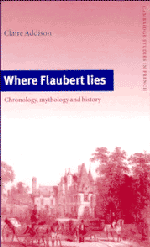Book contents
- Frontmatter
- Contents
- Publisher's note
- Acknowledgement
- Abbreviations and conventions
- Introduction
- 1 The Flaubert dates
- 2 The colours of time in the first Education sentimentale
- 3 Conception, birth, death in Madame Bovary
- 4 Heads and tails in Salammbô
- 5 Two-timing in L'Education sentimentale
- 6 The Hundred Days of Bouvard et Pécuchet
- 7 Petit dictionnaire de Flaubert
- Conclusion
- Diachronic and synchronic charts
- Bibliography
- Index
- Cambridge Studies in French
7 - Petit dictionnaire de Flaubert
Published online by Cambridge University Press: 09 October 2009
- Frontmatter
- Contents
- Publisher's note
- Acknowledgement
- Abbreviations and conventions
- Introduction
- 1 The Flaubert dates
- 2 The colours of time in the first Education sentimentale
- 3 Conception, birth, death in Madame Bovary
- 4 Heads and tails in Salammbô
- 5 Two-timing in L'Education sentimentale
- 6 The Hundred Days of Bouvard et Pécuchet
- 7 Petit dictionnaire de Flaubert
- Conclusion
- Diachronic and synchronic charts
- Bibliography
- Index
- Cambridge Studies in French
Summary
ADOLPHE SCHLESINGER
Adolphe, the ‘noble wolf’ (CY, 409), occupies a marginal position in Flaubert's fictions. Adolphe Duprey was a former name for Léon (NV, 5), and Emma shudders at the boatman's mention of ‘Adolphe … Dodolphe …’ (1, 661) in MB. The name Adolphe-Maurice appears in ES1 through the presence of Adolphe Lenoir (1, 285), who becomes a soldier, as Eugène Arnoux does in ES11 (11, 160). In BeP, on 1 April, the ‘good’ Adolphe who studies his German is juxtaposed with the ‘bad’ Eugène (11, 294), and the Celtic derivation of Eugène is from Eoghan, ‘young soldier’, though its usual derivation is from the Greek for ‘well born’ (ibid., 87). Eugène Arnoux serves in Algeria and in Rome when he is grown up (11, 160, 162), and Gorju brings an African venereal disease from Algeria in BeP. Adolphe Langlois announces Cécile Dambreuse's inheritance from her natural father at the Lupercalia of 15 February 1851, the day of Frédéric Baslin's illegitimate birth and the day after M. Dambreuse was buried near the author of Adolphe on la saint-Adolphe (11, 147).
It is mainly through this language of time that Adolphe is presented in Flaubert's fictions. 14–15 February 240 BC is also the time of Hamilcar's return to Carthage and welcome by Salammbô, and Flaubert wrote ‘lares’ in the plans to symbolise Hamilcar's return (Green, 39). The Hamilcar–Hannibal relationship in Salammbô is linked most specifically with the 14–15 February of Hamilcar's return and with the 1 April when Hamilcar saves his son's life through the substitution of another child.
- Type
- Chapter
- Information
- Where Flaubert LiesChronology, Mythology and History, pp. 216 - 281Publisher: Cambridge University PressPrint publication year: 1996



